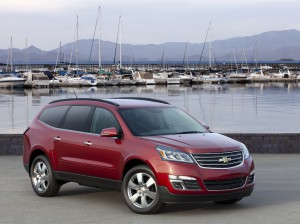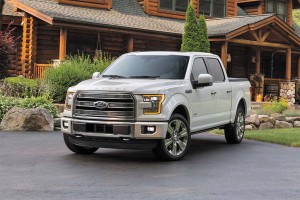
The growing popularity of crossovers, like the Chevy Traverse, is helping to drive down the average fuel economy of new vehicles in the U.S.
With gasoline prices sliding toward $2 per gallon and the oil glut showing no signs of abating, the average fuel economy of new vehicles purchased in the U.S. declined in August.
Sales of crossover vehicles and pickup trucks remain strong as a result of the pricing, and that appears to be the reason for the dip in the overall gas mileage rating of new vehicles sold in the U.S. slightly last month, according to researchers at the University of Michigan Transportation Research Institute.
Continued expansion of the offerings within the crossover utility and pickup truck segments are helping to sustain the strong demand trend, added Christopher Hopson, IHS director of light vehicle forecasting.
While automakers are using a variety of technological tricks, such as turbocharging smaller motors and increasing the amount of lighter weight materials, to improve economy of those vehicles, they are offsetting the substantive gains in overall average gas-mileage in the U.S.

Despite efforts by makers to improve the fuel economy of large vehicles, like the Ford F-150, they still lag their smaller counterparts.
Average fuel economy or window-sticker values of cars, light trucks, vans and SUVs purchased in August was 25.3 miles per gallon, down 0.1 mpg from July.
“This decline likely reflects the decreased price of gasoline in August and the consequent increased sales of light trucks and SUVs,” said Michael Sivak, a research professor at University of Michigan Transportation Research Institute.
Overall, fuel economy of all light-duty vehicles, including cars, pickup trucks, vans, sport utility vehicles improved 52% from 1973 to 1991, but only 10% since from 19.6 to 21.6 mpg, according to a recent study by UMTRI.
The UMTRI study noted fuel economy for cars improved from 13.4 mpg in 1973 to 21.2 mpg in 1991, But after heavy lobbying the automotive industry against tougher regulations reached only 23.4 mpg by 2013.
(Cadillac teases new XT5 crossover ahead of Dubai unveiling. For more, Click Here.)
For light trucks such as pickups, vans and SUVs, the numbers were 9.7 mpg in 1966, 17 mpg in 1991 and 17.2 mpg in 2013. Medium- and heavy-duty trucks showed modest improvement from 5.6 mpg in 1966 to 6.4 mpg in 2013.
Overall, the fuel economy is down 0.5 mpg from the peak reached in August 2014, but up 5.2 mpg from October 2007 — the first full month of monitoring by Sivak and colleague Brandon Schoettle.
(Click Here for details about the new love for the long-reviled Pontiac Aztek.)
In addition to average fuel economy, Sivak and Schoettle issued a monthly update of their national Eco-Driving Index, which estimates the average monthly emissions generated by an individual U.S. driver.
The EDI takes into account both the fuel used per distance driven and the amount of driving.
(To see more about Chrysler recalling 1.5 million trucks, Click Here.)
During June, the EDI remained at 0.82 (the lower the value, the better) for the second straight month. The index currently shows emissions of greenhouse gases per driver of newly purchased vehicles are down 18 percent, overall, since October 2007. EDI reached its best level (0.78) in August 2014.
